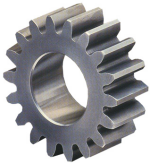GEOM internal pair.xls

Description
Calculates the geometry of an internal pair of gears.
Calculation Reference
Machine Design
To calculate the geometry of an internal pair of gears, consider the following parameters:
- Module (m): The module is the ratio of the pitch diameter to the number of teeth, and it should be the same for both gears to ensure proper meshing. The module is typically measured in millimeters per tooth (mm/tooth).
- Number of teeth on the pinion (Np): The smaller, externally-toothed gear is called the pinion.
- Number of teeth on the internal gear (Ng): The larger, internally-toothed gear is called the internal gear.
- Pressure angle (φ): The pressure angle is the angle between the line of action and the line tangent to the pitch circle at the point of tooth engagement. The pressure angle is typically 20° or 14.5° for most gears, but it can vary based on the application.
Now, you can calculate the geometry of an internal pair of gears using the following formulas:
-
Pitch diameters: Dp = m * Np (pitch diameter of the pinion) Dg = m * Ng (pitch diameter of the internal gear)
-
Base diameters: Dbp = Dp * cos(φ) (base diameter of the pinion) Dbg = Dg * cos(φ) (base diameter of the internal gear)
-
Addendum and dedendum: Addendum (ha) is the radial distance between the pitch circle and the tooth tip. Dedendum (hf) is the radial distance between the pitch circle and the tooth root. For standard gears, the addendum and dedendum are typically:
ha = m hf = 1.25 * m
- Clearance: Clearance (c) is the distance between the tooth tip of one gear and the tooth root of the other gear when the gears are in mesh. It is usually calculated as:
c = hf - ha
-
Outside diameters: Outside diameter of the pinion (Dop) = Dp + 2 * ha Outside diameter of the internal gear (Dog) = Dg + 2 * hf
-
Center distance: Center distance (C) is the distance between the centers of the pinion and the internal gear. It can be calculated as:
C = (Dp + Dg) / 2
These formulas will help you calculate the geometry of an internal pair of gears. Make sure to use consistent units (e.g., millimeters) when performing the calculations.
Calculation Preview
Full download access to any calculation is available to users with a paid or awarded subscription (XLC Pro).
Subscriptions are free to contributors to the site, alternatively they can be purchased.
Click here for information on subscriptions.
